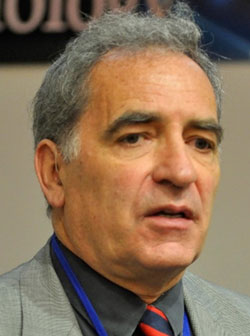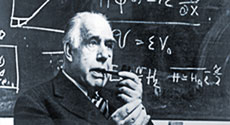Niels Bohr Lecture by Robert H. Austin
Collective Many-body Effects in Biology

Robert H. Austin is a Fellow of the American Physical Society, a Fellow of the American Association for the Advancement of Science, and was elected a member of the National Academy of Sciences USA.
Abstract: I have tried to get away from “one-body” fitness concepts in biology, and to take the next steps towards intrinsically many-body phenomena in biology. Although part of my work has involved testing quantum mechanics in sub-picosecond aspects of many-body effects in biology, I do think there are other coherent phenomena which are in some sense analogous to quantum mechanics in biology.
At the highest level, ecological system display collective many-body dynamics over vast ranges of space and time, which have wave-like properties. Some of the most fundamental questions in biology arise when we ask how such collective behavior is generated and regulated.
I’ll try to highlight recent advances in this broad area and to share ideas about how biology and physics can address these problems at a deep level.
About the speaker: Robert H. Austin received his B.A. in Physics from Hope College in Holland MI and his Ph.D. in Physics from the University of Illinois Champaign-Urbana in 1976. He was a post-doc at the Max Planck Institute for Biophysical Chemistry from 1976-1979 and has been at Princeton University in the Department of Physics from 1979 to the present, achieving the rank of Professor of Physics in 1989.
His Research Group in Biophysics focuses primarily on the use of microarrays and nanotechnology to further the physical understanding of biological processes, such as the dynamics of cells when subjected to stress. The overarching aim is to ultimately understand, and possibly guide, the evolution of microorganisms by culturing them inside custom-made micro environments.
- Wednesday, June 15, 2016 at 15:15 in Aud. 3 at HCØ.
Robert H. Austin is a Fellow of the American Physical Society, a Fellow of the American Association for the Advancement of Science, and was elected a member of the National Academy of Sciences USA. He has served as a President of the Division of Biological Physics of the American Physical Society, and is the present Chair of the U.S. Liaison Committee of the International Union of Pure and Applied Physics. He has served as the biological physics editor for Physical Review Letters, serves on numerous review panels for NIH, NSF, the Burroughs Wellcome Fund and NIST, and is the Editor of the Virtual Journal of Biological Physics. He won the 2005 Edgar Lilienfeld Prize of the American Physical Society and has received honorary degrees from Brown University, Duke University, Bard College, and the University of Antwerp.
|
Coffee and Cookies
Coffee, tea and cookies will be served outside the auditorium 15 minutes before the lecture.

 Niels Bohr Lectures
Niels Bohr Lectures